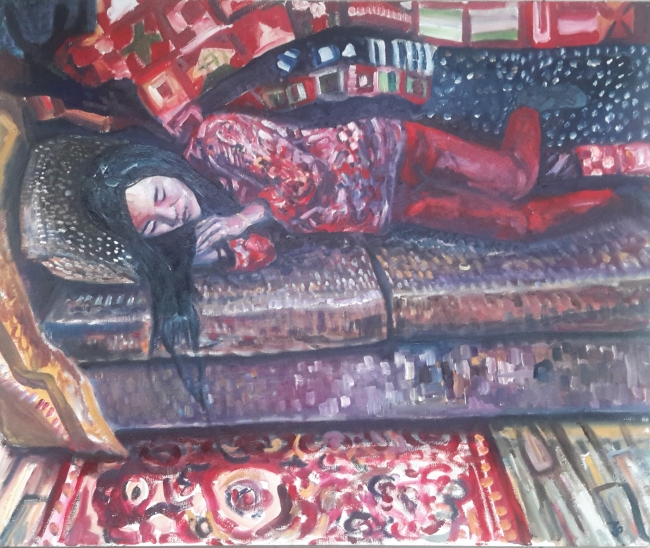To say that Andy Brown uses a diverse set of art media would be an understatement.
Brown enjoyed a brief moment of fame in his native England, when his teabag portraits of the queen appeared on TV and in trivia board game questions.
These days he is still making art, but has stitched together the variety of genres he has cycled through over the last five years into one exhibition.
Brown has used patchwork, pinhole camera photography, etchings, portraits and other media.
“They are all about being overseas, being in Korea, places I’ve traveled to, people I’ve met,” he said.
“I mean, this (portrait) of the queen, it’s a bit poppy and it could be seen as having a lack of depth to it, but that’s not really the case because every piece (of cloth) has a story attached to it. Every bit of fabric I could tell you where that came from and who I was with.”
The work acts as a diary for Brown, as documents of where he was or what he was thinking at a particular time. Images from money ― portraits of Benjamin Franklin, King Sejong and the Queen, for instance ― often crop up in his work.
“It’s an indicator of travel,” he explains. “Whatever money you’ve got in your pocket generally says where you are.”
 |
“Miss Park” by Andy Brown |
A more recent piece is a self portrait inspired by Matisse. It takes the form of a patchwork-filled outline, resembling giant hillside chalk carvings such as the Long Man of Wilmington in the south of England.
“I was choosing different patchwork patterns to represent different parts of the body or different feelings but it was obviously … like the Long Man of Wilmington and that sort of thing, ‘I am here, this is me,’ existence.”
At the same time, the figure, like the Long Man, appears to be floating, without a fixed context. Instead, shapes surround it, and a ship hovers above his left shoulder, destination uncertain.
“There is also some sort of tension in the fact that these pieces are stuck together,” he said. “They are made of things that are being held together. None of it is completely permanent or fixed.”
Brown has painted a large number of portraits this year, a genre to which he said he often returns.
Here again there is a transient feel. A girl sleeps on a sofa in one. Surrounded by patterned fabric, she almost appears to be floating.
Brown, who lived in Busan for three years but now teaches art at a private school in Seoul, said it was time to exhibit in the city in which he lives.
“I have just been enjoying making it, without having to think that it’s got to have a reason, it’s got to have this outcome, it’s got to have this goal. It works out well because I am not forcing myself,” he said.
“That’s part of the buzz and part of the process. It pushes you in another way and makes you think about it in another way. I want to get some feedback again.”
He said he is now planning a couple of projects, including a series of one-man protests about trivial things and a collaboration documenting the history of British involvement in Korea.
“I think it goes both ways. In the U.K. … generally I don’t think we know a lot about Korea,” he said. “But also vice versa, I think a lot of Koreans expect that we are all teaching English and they don’t really know an awful lot about us.”
The exhibition runs April 18-30 at Laheen Gallery in Seocho-gu, Seoul.
By Paul Kerry (
paulkerry@heraldcorp.com)








